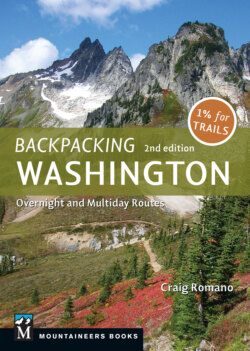Читать книгу Backpacking Washington - Craig Romano - Страница 14
На сайте Литреса книга снята с продажи.
WEATHER
ОглавлениеMountain weather in general is unpredictable, and in the Cascades, Olympics, Blue Mountains, and Selkirks, you can experience all kinds of interesting weather, from high winds and thunderstorms to summer snowstorms. Weather patterns are radically different on the west and east sides of the state. The west side is influenced more by Pacific Ocean currents, creating a more temperate climate with a copious amount of rainfall, heavy from November to April. Summers are generally mild, with extended periods of no or low rainfall. July through early October is generally a delightful time to hike the western region.
In the east, weather patterns are representative of a continental climate, with cold winters and hot, dry summers. Snowfall is usually light due to the Cascades’ rainshadow effect. But higher elevations see ample snowfall, as storm clouds move eastward and are pushed up over the mountains, cooling and releasing their moisture. The heaviest rains usually occur along the Olympic Mountains’ western front. The heaviest snowfall usually occurs at or near the Cascade crest. And in eastern Washington, the heaviest precipitation occurs in the state’s northeast corner.
Plan your hike accordingly, but no matter where you hike in the region, always pack raingear. Being caught in a sudden rain- or windstorm with inadequate clothing can lead to hypothermia (loss of body temperature), which can be deadly if not treated immediately. Most hikers who die of such exposure do so not in winter but during the milder months when a sudden change of temperature accompanied by winds and rain sneaks up on them. Always carry extra clothing layers, including rain and wind protection.
Dramatic campsite in Goat Rocks Wilderness (Trip 23)
WHOSE LAND IS THIS?
All of the hikes in this book are on public land. What’s confusing, however, is who exactly is in charge of this public trust. The majority of the trips in this book are in national forests administered by the US Forest Service. A division of the Department of Agriculture, the Forest Service strives to “sustain the health, diversity, and productivity of the Nation’s forests and grasslands to meet the needs of present and future generations.” The agency purports to do this under the doctrine of “multiple-use,” in which lands are managed for wildlife preservation and timber harvest, foot traffic, and motorbikes. However, supplying timber products, managing wildlife habitat, and developing motorized and nonmotorized recreation options have a tendency to conflict with each other. Several areas administered by the Forest Service have been afforded stringent protections as federal wilderness (see “Untrammeled Washington” in the South Cascades section), barring development, roads, mountain bikes, and motorized recreation.
The National Park Service, a division of the Department of the Interior, manages nearly two million acres of land within Washington. The Park Service’s primary objective is quite different from that of the Forest Service. The agency is dedicated to preserving “unimpaired the natural and cultural resources and values of the National Park System for the enjoyment, education, and inspiration of this and future generations. In other words, the primary focus of the Park Service is preservation.
It’s important that you know which agency manages the land where you’ll be backpacking, for each has its own fees and rules. For example, dogs are generally prohibited in national parks and national wildlife refuges, allowed in national forests, and allowed only on leash in popular national forest areas. Remember, we have a say in how our lands are managed, and we can let the agencies know whether we like what they’re doing or not.
While snow blankets the high country primarily from November through May, it can occur any time of year at higher elevations. Be prepared. Lightning is rare in the Olympics and along the west slope of the Cascades but is common during summer months on the eastern slope of the Cascades and in eastern Washington mountain ranges. If you hear thunder, get off of summits and away from water. Take shelter, but not under big trees or rock ledges. If caught in an electrical storm, crouch down, making minimal contact with the ground and wait for the boomer to pass. Remove your metal-framed pack and ditch the trekking poles! For more detailed information on this subject, refer to Jeff Renner’s excellent book Lightning Strikes: Staying Safe Under Stormy Skies.
River and creek crossings can be extremely dangerous after periods of heavy rain or snowmelt. Always use caution and sound judgment when fording. Also be aware of snowfields. Depending on the severity of the past winter, and the weather conditions of the spring and early summer, some trails may not melt out until well into summer. In addition to presenting potentially treacherous footing and difficulties in routefinding, lingering snowfields can be prone to avalanches or slides. Use caution crossing them. Finally, strong winds are another concern. Avoid hiking during extreme windy periods, which can fell trees and branches. And be aware of forest fires and impending trail closures due to them.
